President Bush Signs Project Bioshield Act of 2004
July 21, 2004: Project BioShield authorizes $5.6 billion over 10 years for the government to purchase and stockpile vaccines and drugs to fight anthrax, smallpox and other potential agents of bioterror.
| ||
| As Vice President Dick Cheney stands by his side, President George W. Bush delivers remarks during the signing ceremony of S.15-Project Bioshield Act of 2004, in the Rose Garden Wednesday, July 21, 2004. "The bill I am about to sign is an important element in our response to that threat. By authorizing unprecedented funding and providing new capabilities, Project BioShield will help America purchase, develop and deploy cutting-edge defenses against catastrophic attack," said the President |
For Immediate Release
Office of the Press Secretary
July 21, 2004
President Bush Signs Project Bioshield Act of 2004 Office of the Press Secretary
July 21, 2004
Remarks by the President at the Signing of S.15 - Project Bioshield Act of 2004
The Rose Garden
9:43 A.M. EDT
THE PRESIDENT: Thank you, all. Mr. Speaker. Please be seated. Thanks. Good morning, and welcome to the Rose Garden. On September the 11th, 2001, America saw the destruction and grief terrorists could inflict with commercial airlines turned into weapons of mass murder. Those attacks revealed the depth of our enemies' determination, but not the extent of their ambitions. We know that the terrorists seek an even deadlier technology. And if they acquire chemical, biological or nuclear weapons, we have no doubt they will use them to cause even greater harm.
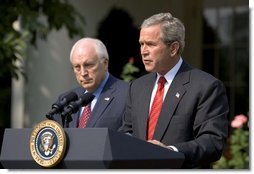 The bill I am about to sign is an important element in our response to that threat. By authorizing unprecedented funding and providing new capabilities, Project BioShield will help America purchase, develop and deploy cutting-edge defenses against catastrophic attack.
The bill I am about to sign is an important element in our response to that threat. By authorizing unprecedented funding and providing new capabilities, Project BioShield will help America purchase, develop and deploy cutting-edge defenses against catastrophic attack. This legislation represents the collective foresight and considered judgment of United States senators and members of the House of Representatives from both political parties -- many of whom experienced bioterror firsthand when anthrax and ricin were found on Capitol Hill. It reflects 18 months of hard work and cooperation by many dedicated public servants in Congress and in the White House. It sends a message about our direction in the war on terror. We refuse to remain idle while modern technology might be turned against us; we will rally the great promise of American science and innovation to confront the greatest danger of our time.
I want to thank the Vice President for his hard work. He was the point man in the White House on this piece of legislation and did an excellent work. I appreciate Secretaries Tommy Thompson and Tom Ridge for their leadership on this important piece of legislation, as well. I appreciate the Speaker and Leader Frist for making this bill a priority.
I want to thank Senator Gregg and Senator Kennedy and Senator Cochran for working on this bill. I appreciate the efforts. I appreciate Congressmen Barton, Billy Tauzin, Chris Cox and Henry Waxman, as well, for their hard work.
I appreciate the members of my administration who are here, thanks for coming. These will be the implementers of this important piece of legislation.
Project BioShield will transform our ability to defend the nation in three essential ways. First, Project BioShield authorizes $5.6 billion over 10 years for the government to purchase and stockpile vaccines and drugs to fight anthrax, smallpox and other potential agents of bioterror. The Department of Health and Human Services has already taken steps to purchase 75 million doses of an improved anthrax vaccine for the Strategic National Stockpile. Under Project BioShield, HHS is moving forward with plans to acquire a safer, second generation smallpox vaccine, an antidote to botulinum toxin, and better treatments for exposure to chemical and radiological weapons.
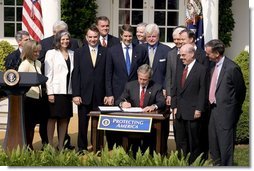 Private industry plays a vital role in our biodefense efforts by taking risks to bring new treatments to the market, and we appreciate those efforts.
Private industry plays a vital role in our biodefense efforts by taking risks to bring new treatments to the market, and we appreciate those efforts.By acting as a willing buyer for the best new medical technologies, the government ensures that our drug stockpile remains safe, effective and advanced. The federal government and our medical processionals are working together to meet the threat of bioterrorism -- we're making the American people more secure.
Second, Project BioShield gives the government new authority to expedite research and development on the most promising and time-sensitive medicines to defend against bioterror. We will waste no time putting those new powers to use. Today, Secretary Thompson will direct the NIH to launch two initiatives -- one to speed the development of new treatments for victims of a biological attack, and another to expedite development of treatments for victims of a radiological or nuclear attack. Under the old rules, grants of this kind of research often took 18 to 24 months to process. Under Project BioShield, HHS expects the process to be completed in about six months. Our goal is to translate today's promising medical research into drugs and vaccines to combat a biological attack in the future -- and now we will not let bureaucratic obstacles stand in the way.
Third, Project BioShield will change the way the government authorizes and deploys medical defenses in a crisis. When I sign this bill, the Food and Drug Administration will be able to permit rapid distribution of promising new drugs and antidotes in the most urgent circumstances. This will allow patients to quickly receive the best available treatments in an emergency. Secretary Thompson has directed the FDA to prepare guidelines and procedures for implementing this new authority. By acting today, we are making sure we have the best medicine possible to help the victims of a biological attack.
Project BioShield is part of a broader strategy to defend America against the threat of weapons of mass destruction. Since September the 11th, we've increased funding for the Strategic National Stockpile by a factor of five, increased funding for biodefense research at NIH by a factor of 30, secured enough smallpox vaccine for every American, worked with cities on plans to deliver antibiotics and chemical antidotes in an emergency, improved the safety of our food supply, and deployed advanced environmental detectors under the BioWatch program to provide the earliest possible warning of a biological attack.
 The threat of bioterrorism has brought new challenges to our government, to our first responders and to our medical personnel. We are grateful for their service. Not long ago, few of these men and women could have imagined duties like monitoring the air for anthrax, or delivering antibiotics on a massive scale. Yet, this is the world as we find it; this nation refuses to let our guard down.
The threat of bioterrorism has brought new challenges to our government, to our first responders and to our medical personnel. We are grateful for their service. Not long ago, few of these men and women could have imagined duties like monitoring the air for anthrax, or delivering antibiotics on a massive scale. Yet, this is the world as we find it; this nation refuses to let our guard down. Tomorrow, the 9/11 Commission will issue its findings and recommendations to help prevent future terrorist attacks. I look forward to receiving the report. I will continue to work with the Congress and state and local governments to build on the homeland security improvements we have already made. Every American can be certain that their government will continue doing everything in our power to prevent a terrorist attack. And if the terrorists do strike, we'll be better prepared to defend our people because of the good law I sign today.
It's my honor to invite the members of the Congress to join me as I sign the Project BioShield Act of 2004. Thanks for coming. (Applause.)
(The Act is signed.) (Applause.)
END 9:50 A.M. EDT
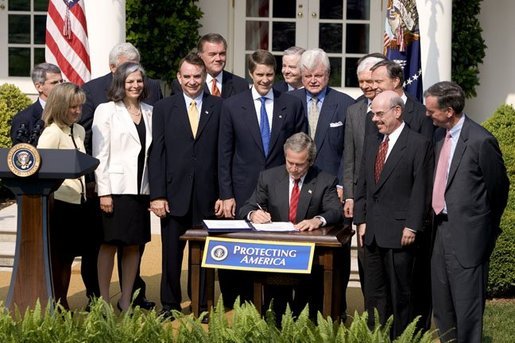
President George W. Bush signs S.15-Project Bioshield Act of 2004, in the Rose Garden Wednesday, July 21, 2004.
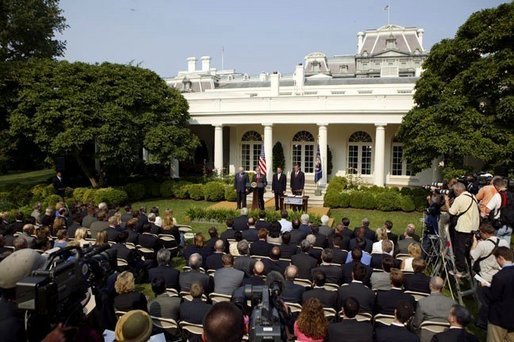
Standing with, from left, Vice President Dick Cheney, Secretary of Health and Human Services Tommy Thompson and Secretary of Homeland Security Tom Ridge, President George W. Bush delivers remarks during the signing ceremony of S.15-Project Bioshield Act of 2004, in the Rose Garden Wednesday, July 21, 2004.
Fact Sheet: Progress in the War on Terror
July 21, 2004
FACT SHEET: PROGRESS IN THE WAR ON TERROR
Today’s Presidential Action
- President Bush today signed into law Project BioShield, which provides new tools to improve medical countermeasures protecting Americans against a chemical, biological, radiological, or nuclear (CBRN) attack.
- The President first proposed Project BioShield in his 2003 State of the Union address and Congress approved it last week. Project BioShield is a comprehensive effort overseen jointly by Secretary Thompson and Secretary Ridge, and involving other Federal agencies as appropriate, to develop and make available modern, effective drugs and vaccines to protect against attack by CBRN weapons. Project BioShield will:
- Expedite the conduct of NIH research and development on medical countermeasures based on the most promising recent scientific discoveries.
- Give FDA the ability to make promising treatments quickly available in emergency situations – this tightly controlled new authority will enable access to the best available treatments in the event of a crisis.
- Ensure that resources are available to pay for “next-generation” medical countermeasures. Project BioShield will allow the government to buy improved vaccines or drugs. The fiscal year 2004 appropriation for the Department of Homeland Security included $5.6 billion over 10 years for the purchase of next generation countermeasures against anthrax and smallpox as well as other CBRN agents.
- As the result of the Project BioShield legislation, the Administration has already begun the process of acquiring several new medical countermeasures:
- 75 million doses of a second generation anthrax vaccine to become available for stockpiling beginning next year.
- New medical treatments for anthrax directed at neutralizing the effects of anthrax toxin.
- Polyvalent botulinum antitoxin.
- A safer second generation smallpox vaccine.
- Initial evaluation of treatments for radiation and chemical weapons exposure.
- Today, based on the new BioShield authorities, Secretary Thompson will launch multi-year initiatives to develop advanced treatments and therapeutics for exposure to biological agents and radiation poisoning.
- Today’s action is just the latest step the President has taken to win the War on Terror and protect our homeland. America is safer and stronger than it was three years ago as a result of President Bush’s leadership.
Background: Three Years of Progress in the War on Terror
Protecting Our Homeland
- Almost three years have passed since the last attack on American soil, but the danger is still clear. As President Bush reminded the Nation in his State of the Union address, “[I]t is tempting to believe that the danger is behind us. That hope is understandable, comforting – and false.” President Bush has made winning the War on Terror and securing our homeland a top priority.
- Creating the Department of Homeland Security (DHS): The President has led the most extensive reorganization of the Federal government in 50 years by creating DHS. DHS brought together 22 entities and over 180,000 employees with critical homeland security missions and provided the Nation with a single Federal department with the primary mission to protect the homeland against terrorist threats.
- FBI Reform: The President transformed the FBI into an agency focused on preventing terrorist attacks through intelligence collection and other key efforts, while improving its ability to perform its traditional role as a world-class law enforcement agency.
- Homeland Security Funding: Since 2001, the President has:
- Proposed a near tripling of FY 2001 funding for homeland security. The FY 2005 budget will increase homeland security funding by 9.7% over FY 2004 – not counting homeland security funding in the Department of Defense and Project BioShield.
- Strengthened counterterrorism efforts through the Department of Justice, proposing a 19% increase in homeland security funding over FY 2004 to $2.6 billion. The FY 2005 budget also brings overall FBI funding to $5.1 billion, a $1.9 billion (60%) increase over the FY 2001 level.
- Allocated more than $13 billion to help state and local governments prepare for terrorism. President Bush has sought and secured historic and massive increases in funding for first responder terrorism and public health preparedness since September 11, 2001. The President feels strongly that these funds should be spent on training and equipping first responders for terrorism preparedness and response, which is one of our nation’s top homeland security priorities.
- Transportation Security: The Administration instituted a multi-layered strategy to enhance aviation security, from the curb to the cockpit. The Transportation Security Administration (TSA) screens 100% of commercial air passengers and checked bags; TSA has trained and authorized hundreds of pilots to carry firearms in the cockpit, directed the hardening of cockpit doors on 6,000 commercial aircraft and stationed explosives detection canine teams at each of the Nation’s largest airports; and Federal Air Marshals ride aboard tens of thousands of flights each month.
- Border Security:
- Three years ago, there were inspectors from three different Federal agencies at our ports of entry. Today, through DHS, the Bureau of Customs and Border Protection (CBP) consolidates all port inspection activities into a single workforce to create "one face at the border." The Border Patrol is also part of CBP, creating synergy between inspectors at the ports and those patrolling between them. More than 18,000 CBP Officers, 1,400 CBP Agriculture Specialists, and 11,000 Border Patrol Agents guard our Nation’s borders.
- The US-VISIT entry-exit system uses cutting-edge biometric technology to help ensure that our borders remain open to legitimate travelers but closed to terrorists. US-VISIT was launched at 115 airports and 14 seaports across the country and is expanding to all land ports of entry. This program has been very successful, processing more than 6.2 million travelers since January and over 850 individuals have been matched who are the subjects of a look out.
- Port and Cargo Security:
- The President has significantly increased funding for the Coast Guard, including dramatic increases for port security and acquisition of new resources. The Coast Guard is creating thirteen 100-person Maritime Safety and Security Teams, to provide point defense for critical infrastructure and high value shipping; employed armed helicopters to provide waterside security; and reviewed thousands of new vessel, facility, and port security plans. Funding for Coast Guard port security efforts has increased over 500% from the beginning of this Administration through 2004. The Coast Guard’s Deepwater fleet modernization project has received a total of $1.5 billion over the last three years, and the President has requested $678 million in his FY 2005 budget.
- DHS has strengthened measures to protect the Nation from smuggled radioactive materials and nuclear devices, by equipping CBP inspectors, Coast Guard boarding personnel, and Border Patrol agents with portable radiation detectors and installing radiation detection portals at sea, land, rail, and air ports of entry, including mail processing facilities. The first radiation portals were installed in March 2003.
- DHS established the National Targeting Center (NTC), which uses computer-assisted analytical protocols to determine which cargo and passengers destined for the United States present the greatest threat, focusing examinations and inspections on them. The NTC screens data on 100% of inbound seaborne shipping containers (nine million per year) to identify those posing a “high risk;” CBP personnel conduct examinations of 100% of high-risk containers.
- DHS established the Container Security Initiative (CSI), deploying CBP officials to 17 major international seaports to pre-screen shipping containers for illicit or dangerous materials before they are loaded on vessels bound for the United States. CSI includes the ports that ship roughly two-thirds of inbound containers to the United States. Additional ports are being added over the next two years.
- Biodefense: Keeping Americans safe from the threat of bioterrorism has been a priority since the outset of the Administration. Since 2001, over $10 billion has been invested across all aspects of biodefense. In addition to BioShield, the President has pursued aggressively a broad range of efforts to confront the biological weapons threat.
- Approved “Biodefense for the 21st Century” – the first-ever national strategy against bio threats – that provides a roadmap for development of comprehensive U.S. biodefense capabilities.
- Expanded international efforts to secure and keep dangerous biological materials out of the hands of terrorists.
- Deployed early warning environmental sampling systems – the BioWatch program -- making it possible to detect biological weapons attacks against major cities. To date, the BioWatch program has analyzed more than half a million samples.
- Increased biodefense medical research and development within the Department of Health and Human Services to more than $1.5 billion per year since 2003, thirty times the investment in 2001.
- Expanded the Strategic National Stockpile of medicines for treating victims of terror attacks, ensuring that “push packages” can be anywhere in the United States within 12 hours.
- Stockpiled enough smallpox vaccine for every American and vaccinated nearly 500,000 members of the armed services.
- Trained hundreds of thousands of first responders to recognize and respond to the effects of WMD.
- Created the National Biodefense Analysis and Countermeasure Center to systematically apply, for the first time, cutting-edge science to the study of classified intelligence about foreign weapons programs and develop first-class forensics in support of law enforcement investigations of biological crimes.
- Protection of Critical Infrastructure: Since its inception, DHS has visited several of the top chemical sites of concern nationwide and identified measures to improve their security. The Administration continues to work with Congress and the private sector to develop security standards for all chemical facilities.
- Intelligence and Coordination: Since 2001, the President has improved intelligence collection, analysis, and sharing to obtain the best picture of the terrorist threat to the Nation.
- The President established the Terrorist Threat Integration Center, integrating and analyzing terrorism threat-related information collected domestically and abroad, ensuring that intelligence and law enforcement entities are working together. Elements of the Central Intelligence Agency, Department of Defense (DoD), Department of Justice, DHS, and FBI work to close the “seams” in our intelligence analysis.
- The Terrorist Screening Center was established to consolidate terrorist watchlists and provide 24/7 operational support for Federal and other government law enforcement personnel across the country and around the world. The Center ensures that government investigators, screeners, and agents are working off the same unified, comprehensive set of anti-terrorist information – and that they have access to information and expertise that will allow them to act quickly when a suspected terrorist is screened or stopped.
- DHS launched the Homeland Security Information Network (HSIN), a real-time collaboration system to report incidents, crimes, and potential terrorist acts to one another and the DHS Homeland Security Operations Center. The HSIN is now linked to all 50 states and more than 50 major urban areas.
- DoD created U.S. Northern Command, to provide for integrated homeland defense and coordinated DoD support to Federal, state, and local civilian governments.
- The President signed the USA PATRIOT Act, which strengthens law enforcement's abilities to prevent, investigate, and prosecute acts of terror, facilitating Federal government efforts to thwart potential terrorist activity throughout the United States. President Bush continues to call on Congress to take action to ensure that these vital law enforcement tools do not expire.
- Three Commitments in Our Strategy for Peace: To overcome the dangers of our time, America is also taking a new approach in the world. We are determined to challenge new threats – not ignore them and simply wait for future tragedy. Our strategy for peace has three commitments:
- First, we are defending the peace by taking the fight to the enemy – confronting them overseas so we do not have to confront them here at home by destroying the leadership of terrorist networks in sudden raids; disrupting their planning and financing; and shrinking the space in which they can freely operate by denying them territory and the support of governments.
- Second, we are protecting the peace by working with friends and allies and international institutions to isolate and confront terrorists and outlaw regimes. America is leading a broad coalition of nations to disrupt proliferation. We are working with the United Nations, the International Atomic Energy Agency, and other international organizations to take action to preserve our common security.
- Third, we are extending the peace by supporting the rise of democracy – and the hope and progress that democracy brings – as the alternative to hatred and terror in the broader Middle East. In democratic and successful societies, men and women do not swear allegiance to malcontents and murderers; they turn their hearts and labor to building better lives. And democratic governments do not shelter terrorist camps, or attack their peaceful neighbors.
- Three Years of Progress: We have followed this strategy – defending the peace, protecting the peace, and extending the peace – for nearly three years, and the results are now clear for all to see.
- Afghanistan: Three years ago, Afghanistan was the home base of al-Qaida – a country ruled by the Taliban, one of the most backward and brutal regimes of modern history. Today, a presidential election is scheduled for this fall, the terror camps are closed and the Afghan government is helping us to hunt the Taliban and terrorists in remote regions. Today, because we acted to liberate Afghanistan, a threat has been removed, and the American people are safer.
- Pakistan: Three years ago, Pakistan was one of the few countries in the world that recognized the Taliban regime, and al-Qaida was active and recruiting in Pakistan without serious opposition. Yet the United States was not on good terms with Pakistan’s military and civilian leaders – the very people we would need to help shut down al-Qaida operations in that part of the world. Today, the United States and Pakistan are working closely in the fight against terror, and Pakistani forces are rounding up terrorists along their nation’s western border. President Musharraf is a friend of our country, who helped us capture Khalid Sheik Mohammed, the operational planner behind the 9/11 attacks. Today, because we are working with Pakistani leaders, Pakistan is an ally in the war on terror, and the American people are safer.
- Saudi Arabia: Three years ago, terrorists were well established in Saudi Arabia. Inside that country, fundraisers and other facilitators gave al-Qaida financial and logistical help – with little scrutiny or opposition. Today, after attacks in Riyadh and elsewhere, the Saudi government knows that al-Qaida is its enemy. Saudi Arabia is working hard to shut down the facilitators and financial supporters of terrorism, and they have captured or killed many first-tier leaders of the al-Qaida organization in Saudi Arabia – including one last month. Today, because Saudi Arabia has seen the danger and joined the war on terror, the American people are safer.
- Iraq: Three years ago, the ruler of Iraq was a sworn enemy of America, who provided a safe haven for terrorists, had used weapons of mass destruction, and turned his nation into a prison. Saddam Hussein was a proven mass murderer who refused to account for his weapons of mass murder.
- The Bush Administration, Members of Congress, and the United Nations Security Council looked at the intelligence on Iraq and saw a threat. The previous Administration and the Congress looked at the intelligence – and made regime change in Iraq the policy of our country.
- In 2002, the UN Security Council yet again demanded a full accounting of Saddam Hussein’s weapons programs. As he had for over a decade, Saddam Hussein refused to comply. So we had a choice to make: either take the word of a ruthless dictator, or take action to defend America. Faced with that choice, President Bush will defend America every time.
- We were right to go into Iraq, although we have not found stockpiles of weapons of mass destruction. We removed a declared enemy of America, who had defied the international community for 12 years, and who had the capability of producing weapons of mass murder, and could have passed that capability to terrorists bent on acquiring them. In the world after September 11th, that was a risk we could not afford to take.
- Today, the dictator who caused decades of death and turmoil – who twice invaded his neighbors, who harbored terrorist leaders, and used chemical weapons, is finally before the bar of justice. Iraq is now becoming an example of reform to the region. Iraqi security forces are fighting beside coalition troops to defeat terrorists and foreign fighters. Today, because America and our coalition helped to end the violent regime of Saddam Hussein, and because we are helping to raise a peaceful democracy in its place, the American people are safer.
- Libya: Three years ago, Libya, a longtime supporter of terror, was spending millions to acquire chemical and nuclear weapons. Today, thousands of Libya’s chemical munitions have been destroyed and equipment to produce nuclear materials that could ultimately have threatened the lives of hundreds of thousands is stored in Oak Ridge, Tennessee. Today, because the Libyan government saw the determination of the civilized world, and correctly judged its own interests, the American people are safer.
- Weapons Proliferation: Three years ago, a private weapons proliferation network, operated by Pakistani nuclear scientist A. Q. Khan, was selling nuclear plans and equipment to countries like Libya, Iran, and North Korea. Today, the A. Q. Khan network has been exposed, we have ended one of the most dangerous sources of proliferation in the world, and the American people are safer.
- Breaking this proliferation network was possible because of outstanding work by the CIA. Dedicated intelligence officers were tireless in obtaining vital information, sometimes at great personal risk. Our intelligence services do an essential job for America.
- The Senate Intelligence Committee has identified some shortcomings in our intelligence capabilities – and the Committee’s report will help us in the work of reform. President Bush believes that intelligence reform efforts should: 1) increase the number of intelligence agents to cover the globe; 2) invest in the best, cutting-edge technology to listen and look for dangers; and 3) result in better coordination among intelligence services.
- The President proposed the establishment of the Proliferation Security Initiative (PSI). PSI is a broad international partnership of countries which, using their own laws and resources, will coordinate their actions to interdict shipments of dangerous technologies to and from states and non-state actors of proliferation concern – at sea, in the air, and on land.
- The President proposed and the United States led the effort to pass UN Security Council Resolution 1540 which requires states to criminalize proliferation of weapons of mass destruction and their means of delivery by non-state actors, enact and implement effective export controls, and secure proliferation sensitive materials.
- Missile Defense: The United States will soon begin the operational deployment of an initial capability to defend against long-range ballistic missiles from rogue states such as North Korea. While this initially will be a limited capability, it will provide a basis for improvements as the threats and technologies evolve.
###
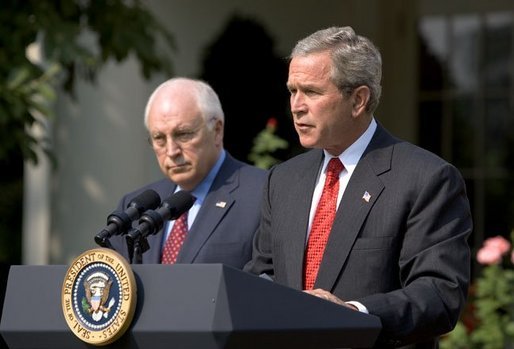
No comments:
Post a Comment